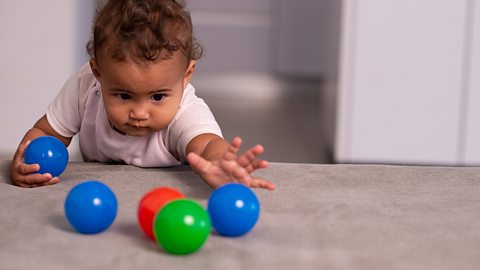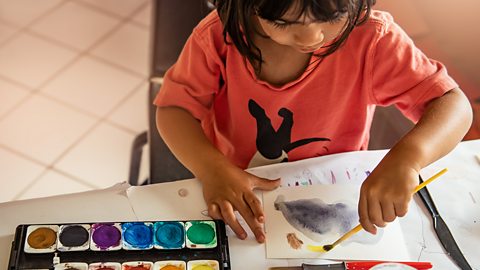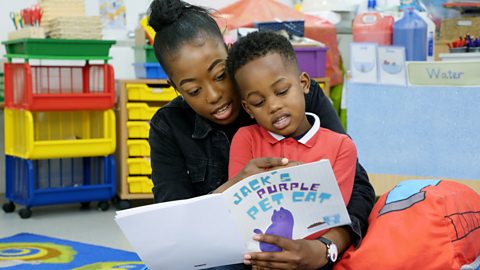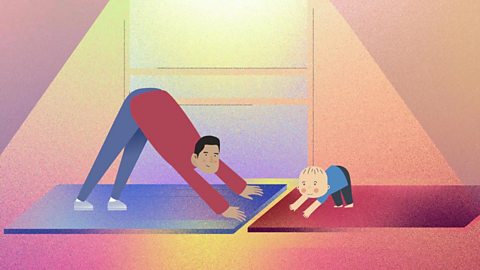As a parent, you might be wondering when you will find out whether your child is right or left-handed.
Roughly 10% of the population are left-handed, which means that they consistently favour using the left hand over the right for lots of activities like writing, painting or even picking up a cup of tea.
But you might have to wait a while before you figure out your little one’s hand preference. We chatted to Occupational Therapist Lindsay Carr to find out more.
When do children develop a preferred hand?
“Handedness can develop anytime during the pre-school years,” says Lindsay. “You can sometimes see it in very young children, even at one year old or less sometimes. But that's not very common.”
At this young age, babies are likely to use both hands equally and swap them all the time. Often, babies will just use the hand closest to what they want to pick up or whichever is most convenient.
A hand preference usually develops between the ages of 18 months to 4 years old.
For all those important things we do with our hands, like… picking up a cup of tea, you'll find that most of us adults are righties. But ten percent of us are lefties.
Babies, however, aren't either. They use both hands equally and swap all the time. These clever little ones will just use the hand that's closest to what they want to pickup or whichever is handiest. It's not until they're between three and five years old that you might get a sense of which hand is dominant and the one they'll then use to get stuff done.
But whether you're a lefty or a righty, or even one of the lucky few who can use both hands equally, it's all to do with brain function and scientists still aren't really sure why this is. It might well come from your genes, but you can still be a lefty even if your entire family are righties. It's just one of life's mysteries.
Lindsay explains, “At this stage there isn’t necessarily a fully dominant hand, but there is perhaps a preference for a hand.”
“It might be that this hand is the one they tend to swap toys into for more complex tasks, or the one they reach out for things with. But I wouldn't say that actual handedness (hand dominance) develops until between 3 and 6 years.”
Every child is unique and develops skills at different times and in different ways. Give them space to explore with both hands and try not to push them to use one over the other when they’re not ready.

Position toys or activities in front, and to the centre, of your child. This is so that they can choose which hand to use rather than using the hand closest to the toy.
Why are some people left-handed?
The exact reason why people have different hand preferences is unknown.
Many believe that left- and right-handedness is linked to our genetics. However, scientists do not know which bits of DNA control it.
And even though we know a baby won’t show their hand preference for a few years after birth, Peter Hepper, from Queen's University in Belfast, has performed an experiment which shows that babies have a hand preference when they’re inside the womb.
He found that nine out of 10 foetuses preferred sucking their right thumb, mirroring the familiar pattern in the general population. And when he followed those children up many years later, the babies who sucked their right thumb in the womb became right-handed, and the ones who preferred their left thumb remained left-handed.

What age can children learn to hold a pen, colour and draw?
“I think it's really difficult to put a definitive age on it,” says Lindsay. “It’s very much down to the individual child.”
“Formalised schooling starts when a child is four and, within that reception year, they will look at mark making.”
Mark making is a term used when a child creates different patterns, lines, textures and shapes. This may be on a piece of paper, on the floor, or on an object or surface.

Mark making forms the basis of writing skills.
“I wouldn’t expect a functional pen grip to be used consistently until a child is around five or six,” Lindsay explains.
“At this age, their little hands continue to develop and their muscles develop too.”
Babies have about 300 bones at birth. These eventually grow together to form the 206 bones of adults. This process, called ossification, is continuous until 25 and affects their hands ability to write.
“Young children have far more bones in their hands because they haven’t fused together yet. So all the muscles and bone structures that need to be in place for writing aren’t fully formed.”
Lindsay says children need a good foundation of both gross and fine motor skills.
“Once they're confident and competent and using their hands in play activities, all of these mark making skills will develop with the fully dynamic pen grip being almost the last thing they learn.”

What are fine and gross motor skills?
Gross motor skills are skills children develop using their whole body.
“It’s being able to use your legs, your arms, your trunk, your body to make movements.”
Once children have that strength and stability that comes from mastering these whole-body, larger motor skills, they will be able to start learning to use their arms and hands for more precise movements.
These precise movements are called fine motor skills. They involve small muscles working with the brain and nervous system to control movements in areas such as the hands, fingers, lips, tongue and eyes.
| Gross motor actions | Fine motor actions |
|---|---|
| Rolling | Holding a pen |
| Sitting | Cutting with scissors |
| Walking | Using a knife and fork |
| Crawling | Putting clothes on |
| Jumping | Doing up buttons |
How can you help your child develop their motor skills?

“I think the key is to give your child many opportunities with lots of different activities,” Lindsay says.
“If a child sits in front of a TV or a screen a lot, they're not exploring their bodies enough. They're not learning what they can do and what they struggle with, and then they haven't had the opportunity to learn from that.”
When it comes to fine motor skills, the same applies. Giving your child a lot of opportunities to explore with their hands, doing a variety of tasks, will build their skills.
“So building, drawing and mark making are all good examples. It’s also good to explore different textures, such as sand, water, slime (made from cornflour and water), bubbles and play dough.”
These activities and opportunities do not have to cost a lot of money. “For gross motor skills, you could just take a walk around your local area,” says Lindsay. “Or create obstacle courses in the house, which involves lots of whole-body movements taking weight through the arms and legs.”
You don’t have to overthink this either - some of this play will just come naturally into your everyday interactions with your child.

| Gross motor activities | Fine motor activities |
|---|---|
| Throwing balls | Banging a pan with a wooden spoon |
| Playing skittles | Building with blocks |
| Dancing | Playing board games |
| Indoor obstacle course | Cooking activities - stirring, measuring, sifting |
| Going to a play park | Arts and crafts activities |
For more inspiration of activities that can help develop motor and language skills, you can check out the bank of Tiny Happy People activities for ages 0-5.
Health visitors, schools and nurseries monitor motor skills and can let you know if there are any concerns about your child’s motor development. If you have any specific concerns about your child’s motor development, you can talk to your health visitor or make an appointment with your GP.

In case you missed it
Introduction to phonological awareness. video
Two films explaining phonological awareness, your child's recognition of the different sounds that make up words in speech.





